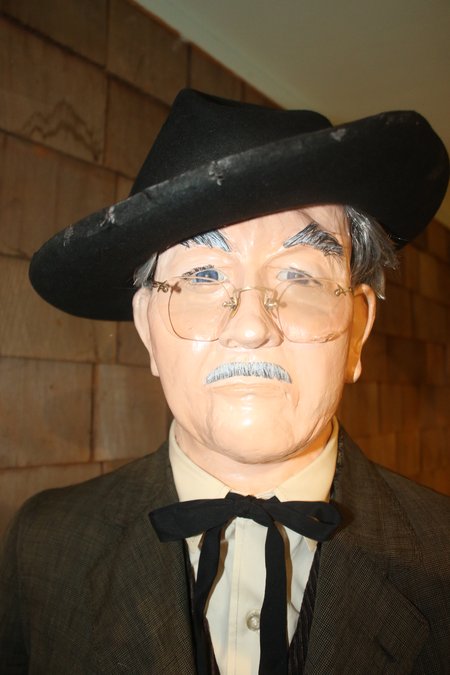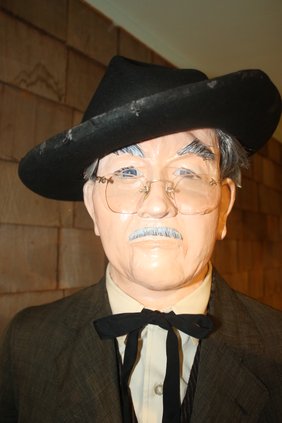LARNED — Since the 1970s, the Santa Fe Trail Center has chronicled the history of Pawnee County along the ruts of the historic Santa Fe Trail, with an extensive collection of authentic artifacts ranging from prehistoric American Indian to trade items during the Trail’s active days and into the early settlement of the county’s various communities. From time to time, notable persons have also been featured, that have made local connections before going on to fame and fortune elsewhere in the country.
Up to now, there has been one particular person missing from the lineup, although the historic Frizzell schoolhouse he attended as a youth was moved to the SFTC’s outdoor museum in 1975.
Last Saturday, about 50 locals attended an invitation-only sneak peek at the SFTC’s newest exhibit honoring Hugh Milburn Stone, an American actor best known for his role as “Doc” (Dr. Galen Adams) on the CBS Western prime-time drama “Gunsmoke, which ran from Sept. 10, 1955, to Sept. 1, 1975. He played the character for the show’s entire 20-year run, appearing in 604 of 635 episodes that ties for longest-running prime-time drama series.
Early in his “Gunsmoke” time, Stone was named a Boot Hill Marshal in 1958. In 1968 he was awarded an Emmy for his role as Doc.
“Gunsmoke” was a huge part of Stone’s life. He once said, “I was bred to play the part of Doctor G. Adams.” Though not a real medical doctor, Stone received an honorary membership from the Kansas Medical Association.
The exhibit is nestled in the western corner of SFTC’s east gallery, depicting Doc standing and facing the gallery center with his characteristic scowl, ready to accost someone who has interrupted the current poker game going on in the Long Branch Saloon. Stone, who was a vaudevillian in his years as young adult, relished the role of Doc as one of his favorite characters in a long screen career. He was always mindful of his Kansas roots, returning to Larned in 1959 for the centennial celebration of Fort Larned, with the cast of “Gunsmoke” in tow.
SFTC Director Katie Norman noted that the exhibit, which opened to the public this week, is currently in its first phase of development, featuring one of Doc’s costumes, life-sized photo cutouts of Stone and actress Amanda Blake, as well as photos taken during the 1959 visit. More items will be added as they become available.
“We do have some photos that haven’t been displayed yet,” Norman said. “The photos will be part of the next phase that we are working on. We’re still working on ideas on what the next phase will be. It’s kind of a small area, so we don’t want to clog it up; we don’t want it to be cluttered.”
Exhibit sponsor Elizabeth Griffin, a local artist, created Stone’s facial expression, and Stephanie Reynolds added his hair and eyebrows. “He was known for his gruff demeanor and a lot of the pictures of him showed that,” Norman explained.
“At this point, we’re just continuing to work on things that we can add to the exhibit.”
Milburn Stone, singer, dancer, actor
Hugh Milburn Stone was born July 5, 1904, the second of four children of Herbert and Laura Belfield Stone in Burrton, Kan. He was born on the Belfield farmstead in rural Burrton. It is not known exactly why the Stone family came to Frizzell in Pawnee County, which they did when Milburn was 3 years old, but Herbert’s professions included grain buyer and operator, as well as owner of a couple grocery stores. Milburn attended the L’Dora schoolhouse while the family lived in the Frizzell community for a period of roughly five years. Herbert died on March 16, 1917, at a Wichita hospital, from complications due to pneumonia. The family then returned to Burrton, where Milburn graduated from Burrton High School. He was active in the drama club, played basketball, and sang in a barbershop quartet.
Although Stone had a congressional appointment to the United States Naval Academy, he turned it down, choosing instead to become an actor with a stock theater company headed by Helen Ross.The Burrton town doctor, Joseph Wakefield Myers, M.D. was the town doctor from 1913 to 1928. Stone was known to have said he styled his portrayal of a country doctor based on Dr. Myers.
In 1919, Stone debuted on stage in a Kansas tent show. He ventured into vaudeville in the late 1920s, and in 1930, he was half of the Stone and Strain song-and-dance act. His Broadway credits include “Around the Corner” (1936) and “Jayhawker” (1934).
In the 1930s, Stone went to Los Angeles to launch his screen career. He was featured in the “Tailspin Tommy” adventure serial for Monogram Pictures. In 1939 he played Stephen Douglass in the movie “Young Mr. Lincoln” with Henry Fonda and Ward Bond. In 1939 he appeared in “When Tomorrow Comes” as head busboy (uncredited). In 1940, he appeared with Marjorie Reynolds, Tristram Coffin, and Stanford Jolley in the comedy espionage film “Chasing Trouble.” That same year, he co-starred with Roy Rogers in the film “Colorado” in the role of Rogers’ brother-gone-wrong.
Stone appeared uncredited in the 1939 film “Blackwell’s Island.” Stone played Dr. Blake in the 1943 film “Gung Ho!” and a liberal-minded warden in Monogram Pictures’ “Prison Mutiny,” also in 1943. Signed by Universal Pictures in 1943, in the films “Captive Wild Woman” (1943), “Jungle Woman” (1943), “Sherlock Holmes Faces Death” (1944), he became a familiar face in features and serials, starring as hero Jim Hudson in “The Great Alaskan Mystery” (1944). In 1944, he portrayed a Ration Board representative in the Universal-produced public service film “Prices Unlimited” for the U.S. Office of Price Administration and the Office of War Information. One of his film roles was a radio columnist in the Gloria Jean-Kirby Grant musical “I’ll Remember April.” He made such an impression in this film that Universal Studios gave him a starring role (and a similar characterization) in the 1945 serial “The Master Key.” The same year, he was featured in the Inner Sanctum murder mystery “The Frozen Ghost.” In 1953, Stone appeared as Charlton Heston’s sidekick in “Arrowhead,” a Western also featuring Brian Keith and Katy Jurado.
In 1955, Gunsmoke was adapted for television and recast with different actors for various reasons. Howard McNear, the radio “Doc Adams,” was replaced by Stone, who gave the role a harder edge consistent with his screen portrayals. He stayed with “Gunsmoke” through its entire television run, with the exception of seven episodes in 1971, when Stone required heart surgery and Pat Hingle replaced him as Dr. Chapman. Stone appeared in 604 episodes through 1975, often shown sparring in a friendly manner with co-stars Dennis Weaver and Ken Curtis, who played, respectively, Chester Goode and Festus Haggen.
Stone and James Arness were the only actors who stayed during the entire run of the series. When the show ended in 1975, Stone retired at the age of 70. On June 12, 1980, Stone died of a heart attack in La Jolla, Calif. Stone is interred at El Camino Memorial Park Cemetery, San Diego, California. He posthumously received an honorary doctorate from St. Mary of the Plains College in Dodge City. He was inducted into the Hall of Great Western Performers of the National Cowboy and Western Heritage Museum in Oklahoma City in 1981. Stone also has a star on the Hollywood Walk of Fame.
A lasting legacy to Stone in the performing arts is the Milburn Stone Theatre in Cecil County, Md. He is a member of Boot Hill Museum’s Kansas Cowboy Hall of Fame, having been inducted as Cowboy Entertainer in 2006. His wife Jane, a Hutchinson native, passed away on Oct. 20, 2002 in Rancho Santa Fe, Calif.
Not many are aware that Stone had an excellent baritone singing voice. While he’s widely known for his acting, he also sang on the show and in other venues, surprising many viewers who didn’t realize he had a musical talent. On the Dean Martin Show in 1969, Stone was featured singing the ballad “Maggie” 10 years after Kitty (Amanda Blake) had sung it on Gunsmoke.





